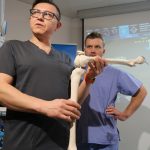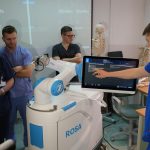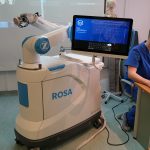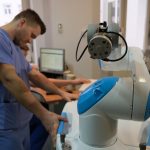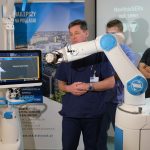For the past two weeks, orthopedic surgeons from the Clinic of Orthopedics, Traumatology, and Hand Surgery at the University Clinical Hospital have been performing knee joint replacement surgeries using the ROSA robot. The initial impressions are promising, and the orthopedic surgeons in Białystok would also like to operate on hip joints using this method.
Although orthopedic surgeries using robots are common in Western Europe and America, they are a novelty in Poland. Białystok has joined a small group of hospitals in Poland performing surgeries with such a robot. The National Health Fund (NFZ) does not yet contract robotic procedures in orthopedics. It covers these surgeries as standard prosthetic procedures without robotic support. So far, eight operations have been performed, and the initial impressions of working with the robot are encouraging.
“For now, we operate slower than without the robot, but we are able to set the angles, bone cutting planes, and achieve joint stability more precisely,” admits Dr. Jan Kiryluk, the head physician of the Orthopedics Clinic at the University Clinical Hospital.
The procedure begins with anesthesia and patient positioning. During this time, the nursing team prepares the instruments and, together with the assisting staff, sets up the robotic device. The robot is dressed in a “sterile cover” and, after initial calibration, is ready to operate. Meanwhile, the surgeons prepare the surgical field and make the initial incisions. Next, so-called “sensors” are implanted, which the robot detects and uses their spatial positions to properly position its arm for bone cuts. The surgeon, using the monitor and after measuring the so-called “landmark points” of the joint, determines the size and planes of the cuts, while the robot suggests whether to accept or adjust the settings. Only after completing this preoperative planning can the surgeons begin the surgery. Currently, this planning phase takes the longest time, while the surgery itself is shorter.
“We must remember that the robot we have does not operate by itself. The surgeon operates. The robot guides how to operate, but it is the surgeon who makes the cuts, places the prosthesis, and sutures the tissues,” explains Dr. Kiryluk.
Surgery using a robot is more expensive but results in less tissue trauma, more precise implant fitting, fewer complications, and fewer potential implant loosening events during the postoperative period. For patients, this means faster recovery, shorter postoperative time, and less pain. According to medical literature, after traditional knee replacement surgery, about 20% of patients are not fully satisfied with the outcomes. This is related to various factors, including the human factor. An experienced orthopedic surgeon operates skillfully but, like anyone, may have an off day, moments of hesitation, and uncertainty. The robot eliminates these weaker days. It guides and allows the surgeon to reflect, but it is the surgeon—not the robot—who makes the final bone cuts.
A less experienced surgeon must first perform many operations under supervision and then independently to operate skillfully. This process takes time, and often only after several, sometimes even over a decade, do they become a proficient and experienced surgeon. The robot significantly shortens this learning curve, enabling a less experienced surgeon, with robotic support, to operate at the level of the best surgeon on their best day.
We encourage you to watch; Dr. Paweł Olszewski explains more details.
The full episode is available at the following link: https://bialystok.tvp.pl/75789078/06022024-godz-1630

